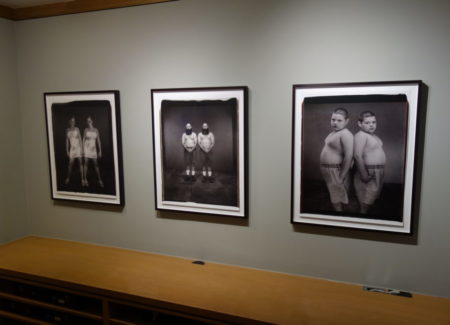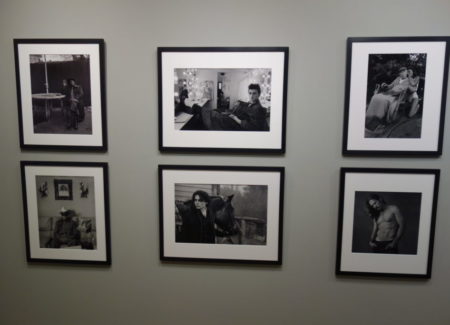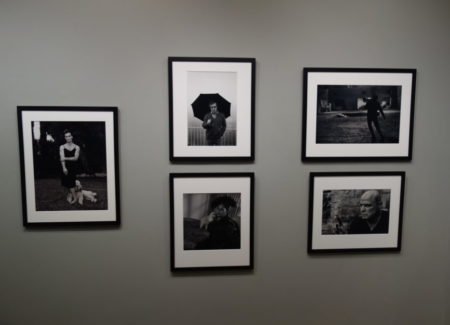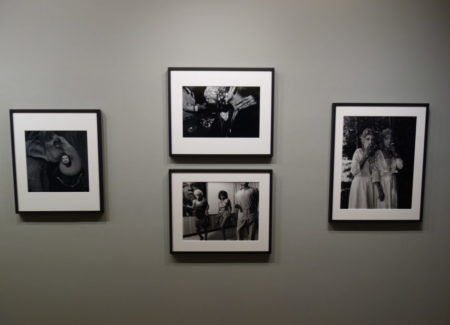JTF (just he facts): A total of 36 black and white and color photographs, framed in black and matted/unmatted, and hung against light grey walls in the main gallery space, the entry area, and the book alcove. 28 of the prints are gelatin silver prints, made between 1965 and 1999 and printed later. These prints are sized either 11×14, 16×20, or 20×24 (or reverse), and are available in editions of 15, 25, or 75. The 6 Polaroid prints were made in 2001, 2002, and 2008. These prints are sized 30×22 and are unique. And the 2 dye transfer prints were made in 1978 and printed later. These prints are sized roughly 19×23 and are available in editions of 15. The exhibit was curated by Melissa Harris. (Installation shots below.)
Comments/Context: In looking at retrospective exhibits, the equivalent of the Goldilocks rule often applies – in terms of size, they can either be too small, too large, or just right. And once a show goes below the too small designation, other labels come into play, from surveys and samplers down to selections and gatherings. The challenge becomes that with decreasing scale, it becomes harder and harder for a show to adequately encompass the breadth and depth of the artist’s entire career – abbreviation inevitably leads to simpler conclusions.
Prior to her death last year, Mary Ellen Mark had consistently made superlative photography (particularly portraiture) for the better part of the past 50 years, so the idea that her career could be summed up in a single room exhibition seems somewhat foolhardy. Given the large number of well executed, stand alone bodies of work in her archive, the fact that this one room would be too small to do them justice seems inevitable. So what we have here is a retrospective that has been slimmed down to the sampler size, with just an image or two from each of her best known projects, plus a larger selection of celebrity portraits. As a result, it adequately clips the tops of the waves of her career, but ultimately fails to deliver the power that a deeper dive into those same projects would have provided – it’s a squint-eyed view of Mark, where we can see the outlines, but generally lose the richness.
The thematic construct underlying this group of choices is “attitude”, an idea that is manifested in both the poses and gazes of Mark’s sitters, and more indirectly, in Mark’s own approach to the world. So more nuanced projects (like Tiny, circus performers, Falkland Road prostitutes, twins, and prom-goers) have been reduced to highlight images with flounce, saltiness, swagger, or a steely stare – Tiny blows a bubble with world weary disregard, blonde teenage twins do sassy mirrored strut, and a Nepalese girl tries on her best come hither look. But Mark’s ability to build trust with all kinds of people brought out plenty of other memorable portraits – rodeo boys with put-on masculinity, a Turkish street girl in a finger-to-chin Lolita pose, a Kentucky husband holding a gun to his wife’s head, and a pair of elderly women putting on some sultry moves at Luigi’s Italian American Club in Miami.
Even when Mark was photographing celebrities, she seems to have been successful at making intimate connections. While Mark’s portraits of famous actors and singers were taken over her entire career, the selections on view point to a repeated look at the quiet darkness and solitude of life in the spotlight. Sean Penn puts his feet up, the Lone Ranger slumps on a couch, Etta James lets her dog lick her tired face, and Woody Allen shrugs in the rain – again and again, Mark went for the off moment, where the guard came down for an instant and the humanity of her sitters was exposed. Marlon Brando’s fascinated look at a dragonfly perched on his finger captures a gentle delicacy that few would attribute to his character in Apocalypse Now, and that kind of engaged subtlety was classic Mark.
In the end, while there is greatness in many places on these walls, my final reaction to this exhibit was a bit closer to frustration than to an appropriate dose of respect – these few examples do provide a handy framework for Mark’s eye, but they leave so much out that the resulting picture distorts the end conclusion. I’m not sure that saucy, self-possessed attitude is what Mary Ellen Mark should be remembered for – the vast majority of her pictures are filled with a deep compassionate humanity that has nothing to do with put on airs, and it’s her attention to those small details of personality that give life to her portraits. While I shouldn’t ever complain about seeing a well-selected group of her pictures, this edit left me a bit wrong-footed, wishing this sampler had offered more new insights and nuanced rarities rather than a high level sweep of appetizers.
Collector’s POV: The prints in this show are priced as follows. The gelatin silver prints are either $8000, $10000, $12000, $15000, or $18000 each, while the Polaroids are $20000 each and the dye transfers are $15000 each. Mark’s work has come up at auction consistently over the past decade, albeit in relatively small numbers (perhaps a handful of lots in any given year). Recent secondary market prices have generally ranged between $1000 and $12000.













